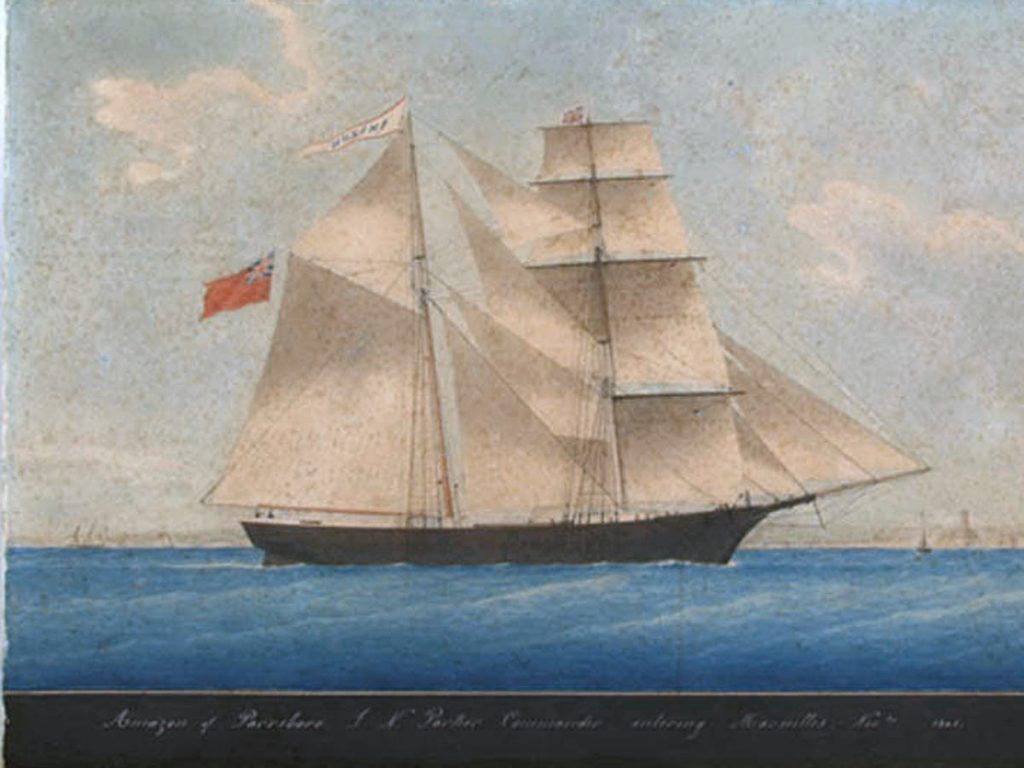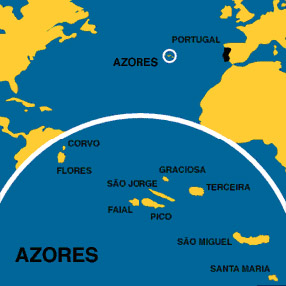
PHOTO: wikimedia
Human beings have always been fascinated by the sea. The open ocean is a wild, untamed thing. It’s in our nature to explore it and try to conquer it. There’s been tales for centuries about the dangers of this unknown frontier – krakens, maelstroms, sirens, rogue waves, and more. One of the most common tales are told about “ghost ships” – a ship where no living crew has been found aboard. A ship empty, with no explanation as to why.
Mary Celeste (sometimes called Marie Celeste) set sail for Genoa from New York on November 7th of 1872. A month later, on December 5th, she was found deserted in the Atlantic Ocean, just off the coast of the Azores archipelago, by a Canadian ship.
The ship was a little damaged, but still certainly seaworthy. There were no signs of distress. Everyone’s personal effects were left in an orderly manner. The ship’s log was written up to nine days earlier. The only clue to the crew and passengers’ whereabouts was the single missing lifeboat.
To this day, nobody knows what caused the crew of the Mary Celeste to simply vanish.
Misadventures and Warning Signs
Mary Celeste’s maiden voyage began in June of 1861, eleven years before she would be found empty and adrift. She was originally registered under the name Amazon. The ship was to take timber on as cargo and transport it across the Atlantic Ocean to London. Curiously, just after supervising the cargo loading, the ship’s first captain, Captain McLellan, took ill. He died on June 19th.
![A modern-day reconstruction of a caravel, the same type of ship as the Mary Celeste [PHOTO: wikimedia]](https://historythings.com/wp-content/uploads/2016/08/Boa_Esperança_Caravel_-_Lagos_Portugal.jpg)
A modern-day reconstruction of a caravel, the same type of ship as the Mary Celeste [PHOTO: wikimedia]
For two years, the Amazon worked in the West Indies trade. For a time, everything was quiet. Parker retired from captaining the ship and was succeeded by a man named William Thompson. Blissful normalcy reigned.
Then, disaster struck yet again.
The Amazon was making her usual round trip when, in October of 1867, a freak storm caught the ship and ran her aground. Damaged beyond repair, the owners abandoned the ship and left her to rot. On October 15th, she was bought by Alexander McBean from Nova Scotia. He sold the shipwreck to another local businessman, who then sold it to an American mariner from, you guessed it, New York. His name was Richard W. Haines.
He put a lot of money into restoring the ship and then registered her as an American ship under a new name: Mary Celeste.
Setting Sail
Several investors put money into Mary Celeste. The ship was reinforced and enlarged and she was given a new captain: a man by the name of Benjamin Spooner Briggs. He came from a long family of mariners, and was married to Sarah Elizabeth Cobb. They had two children: Arthur and Sophia Matilda.Sophia was just a baby when the Mary Celeste was to make her first voyage under her new name. Briggs arranged for his son to be looked after by relatives, and he had his wife and baby daughter quartered with him on the ship to join him on the trip.
He chose his crew with care, and his wife remarked that they seemed “quietly capable”. They were peaceable, skilled sailors and there was not a single man that seemed suspicious.
On November 3rd, 1872, Briggs wrote to his mother, saying: “Our vessel is in beautiful trim and I hope we shall have a fine passage”. The ship was loaded with 1,701 barrels of poisonous denatured alcohol. By Tuesday, November 5th, Mary Celeste was loaded, boarded, and ready to sail.
They had a little trouble getting out initially, but two days later, the weather cleared and the ship sailed out onto the cool, blue Atlantic.
It was the last time anyone on that ship would ever be heard from or seen alive.
The Ghost Ship
Another ship, called Dei Gratia, had set sail eight days after Mary Celeste left port. It was captained by David Morehouse, who was good friends with Briggs. The ship was carrying a cargo of petroleum and headed for Gibraltar.

PHOTO: apdr.pt
At about 1 pm on Wednesday, December 4th, 1872, Dei Gratia was sailing just between the Azores and the coast of Portugal when Morehouse’s first mate called him on deck. He’d seen a ship on the horizon, moving erratically toward them.
Morehouse waited for the ship to drift closer. When it did, he couldn’t see anyone on deck. He sent signals, but only eerie silence answered. So, he sent two men to investigate.
They found the ship utterly deserted. The rigging was damaged, the sails were in poor condition, and the main hatch cover was secure. Oddly enough, the other hatches were open with their covers set neatly beside them on deck. The ship’s compass had fallen from its place, the glass broken. There was about 3.5 feet of water in the hold, but nothing to cause alarm for a ship that large. Back on the deck, they found a makeshift sounding rod (a device used to measure water in the hold of a ship) left lying by itself, as if thrown aside. The ship’s single lifeboat was missing.
The ship’s log was dated to nine days earlier, recording the Mary Celeste‘s position to be just off Santa Maria Island in the Azores, 400 nautical miles away.
Perhaps the strangest and most eerie discovery was that there was no sign of distress. Brigg’s cabin was in good order, his sword sheathed, though some papers were missing. There were plenty of provisions to make it the whole voyage. There was no evidence that a fire had started in the ship or that any struggle had occurred.
The men came back to report to Morehouse, and Mary Celeste was then taken with Dei Gratia to Gibraltar. Dei Gratia reached Gibraltar without any trouble, but the Mary Celeste got stuck in fog and arrived several days later.
Court hearings were held to decide who ought to collect on profit from salvaging the wreck. Investigations were started, questions asked, but nobody could figure out where all the passengers and crew had gone. They had just vanished, inexplicably, without a trace.
Paranormal Theories and Common Explanations
![A waterspout [PHOTO: wikimedia]](https://historythings.com/wp-content/uploads/2016/08/Trombe-1024x754.jpg)
A waterspout [PHOTO: wikimedia]
Mutiny
The initial investigation of the ship headed out of Gibraltar found strange markings on the deck and some traces of what they thought might be blood. The theory was that one of the crew had gotten drunk and then murdered everyone on the ship and then left in the missing lifeboat.
Later testing disproved this theory. The stains weren’t blood at all, and the marks on the ship were natural weathering and the alcohol wasn’t drinkable. Besides, all of the sailors on that ship had been proven to be sensible, capable, good men. It didn’t fit the character of anybody aboard.
Insurance Fraud
Abandoned ships came with a reward for whomever managed to salvage them. The theory was that Briggs and his family were in cahoots with his friend, Morehouse, and faked their deaths in order to collect on a portion of salvage money. Perhaps the crew was in on it, too.
Unfortunately, this theory has no evidence to back it up. It’s simply hearsay.
Piracy
The area around the Azores Islands and Portugal was a haven for dangerous North African pirates. Some posed the theory that the ship could have been attacked by these pirates. The crew and passengers were murdered or taken captive.
Again, this theory doesn’t hold water. Everyone’s personal items were found in good order, including valuables. Why would pirates leave these items behind?
Aliens!
You can hardly touch a historical mystery without finding someone who thinks that aliens did it. Of course, some people out there believe that aliens swooped down and whisked everyone away just moments before the ship was found. This is mostly due to the myth that the log was written up right to moment of discovery and the ship was in pristine condition. That’s a misconception. It’s most likely that the crew was not abducted. Due to the missing lifeboat… they probably abandoned the ship willingly.
Natural Phenomena
Some have posed the theory (based on the makeshift sounding rod and the small amount of water in the hold and the damage done to the ship) that Mary Celeste had run into some trouble at sea.
Perhaps she had hit a violent seaquake, a terrible storm, a rogue wave, or a waterspout. It’s possible the crew misread the sounding rod and thought the problem was worse than it really was and jumped into the lifeboat, fearing for their lives.
Alcohol Explosion
The best explanation we have comes down to what the ship was carrying. She was filled to the brim with industrial-grade alcohol, which is, as you can imagine, extremely combustible. Some people think that, due to damage to the barrels, some fumes escaped and, either a small explosion occurred or, more likely, the crew thought one was about to.
Perhaps they all gathered into the lifeboat and attached the boat to the ship by rope, hoping to wait out the danger and then climb back aboard when it was safe. Maybe the rope broke, leaving them adrift at sea.
What do you think happened? Was it aliens? A waterspout? Mutiny? Imagined danger? Why did the crew vanish? Will anyone ever solve the mystery of the Mary Celeste?


![Benjamin Spooner Briggs [PHOTO: wikimedia]](https://historythings.com/wp-content/uploads/2016/08/Benjamin_Briggs_captain_of_Mary_Celeste.jpg)